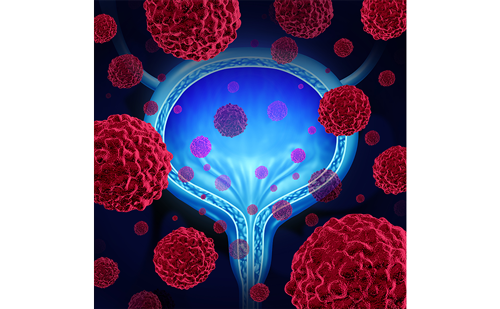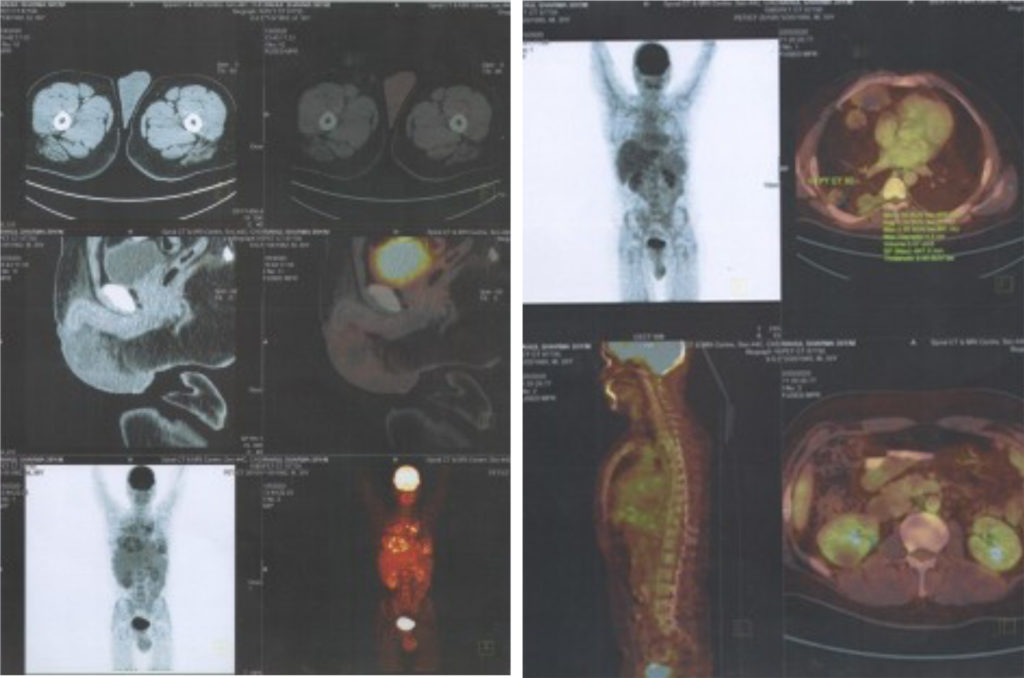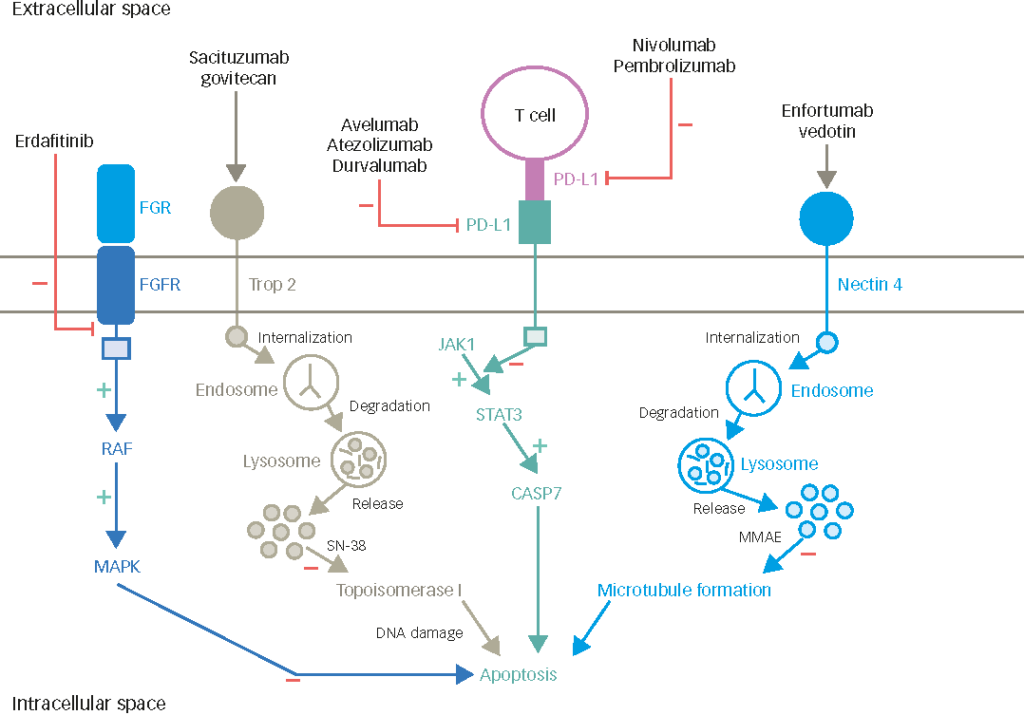Standard Chemotherapy in ‘Fit’ Bladder Cancer Patients
First-line treatment options in ‘fit’ bladder cancer patients who are able to receive platinum-based therapy include GC, paclitaxel/gemcitabine/cisplatin (PGC), methotrexate, vinblastine, doxorubicin and cisplatin (MVAC) with or without granulocyte colony-stimulating factor (G-CSF), or high-dose (HD)-MVAC with G-CSF. The highest level of evidence and grade of recommendation is available for all these combinations.1,2 Some patients display long-term survival following cisplatin-based combination chemotherapy, with 5-year survival rates of approximately 15 %. Moreover, as outlined earlier, patients with lymph node (LN)-only metastases (i.e. no visceral metastases) have better 5-year survival rates (see Table 1).3,4
Chronological versus Functional Age
An important reality in the treatment of bladder cancer is the fact that populations are growing older overall. The incidence of invasive cancer in patients above the age of 65 years is expected to increase dramatically in the next few years.5 Therefore, the matter of comorbid conditions in elderly patients, which is associated with prognostic implications, will become more prominent.6,7 Importantly, an identical chronological age may correspond to a different functional age. Age does not necessarily mean that a patient is unfit to receive platinum-based chemotherapy. Patients are not routinely categorised according to their absolute age. The treatment of bladder cancer in elderly patients is met with a series of challenges, derived from the use of cisplatin, which forms the backbone of standard treatment.
Cisplatin versus Carboplatin in Bladder Cancer Patients
There have been a lot of discussions about the use of cisplatin in the treatment of bladder cancer, specifically in terms of whether this agent is required as part of combination chemotherapy regimens, and whether it is necessary to separate cisplatin-eligible and -ineligible patients.8,9 Currently, there are no data from randomised phase III studies addressing this concern. Whether cisplatin can be replaced safely by carboplatin in cisplatin-eligible patients was investigated in one randomised phase III trial comparing MVAC versus carboplatin plus paclitaxel that was closed early due to slow accrual.10 Other randomised phase II studies compared various cisplatin- and carboplatin-based combinations in patients with recurrent or metastatic bladder cancer. The overarching impression is that carboplatin-based chemotherapy is less active, with reduced CR and survival rates (see Table 2).11–13 Furthermore, several smaller phase II studies evaluating carboplatin in combination with paclitaxel resulted in mediocre outcomes, with OS durations of approximately 9 months and responses below 50 %.14–16
So far, no standard chemotherapy has been established in patients who are ‘unfit’ to receive cisplatin. Approximately 50 % of urothelial cancer patients are not eligible to receive standard cisplatin-based chemotherapy.17–20 Comorbidity and age concerns mean that elderly patients are often under-represented in clinical trials, which makes them unrealistic, because these are representative of a large proportion of bladder cancer patients.21 Patients with a history of cancer have been shown to have an average of three comorbid conditions,22 yet the importance of comorbidity has not consistently been addressed in clinical trials and clinical practice since coming to attention over 40 years ago.23 Clinical trials have tended to exclude elderly patients and/or those with comorbidities, and it is therefore not established whether dosages investigated in clinical trials are safe in the elderly and comorbid population.
Can comorbidity, age, or sex predict risk of mortality in elderly patients? Interesting data have come to the fore, showing that age, sex and comorbidity in particular can be predictive of mortality in elderly patients. Different index scores have been developed to gauge the importance of these factors in patient outcome, but these have so far not been included in clinical trial designs (see Table 3).5,24–27
When deciding on chemotherapy treatment in elderly cancer patients, Wedding et al. have shown in a prospective trial that a comprehensive geriatric assessment (CGA) distinguishes fit patients from vulnerable or frail patients with more precision compared with physician’s evaluations.28 The advantage of using the CGA in elderly patients (≥75 years) is that this assessment provides a description of physiological age. The CGA can detect reversible issues, provide a cognitive function assessment and improve anti-cancer treatment. Although it is not standard, the CGA is recommended for routine use in the older patient population with cancer by several international societies.29,30 The CGA is, however, a time-consuming and costly approach that requires further validation.
In a recent publication by Hurria et al., a score was constructed to predict chemotherapy toxicity in older adults with cancer, with more accuracy than Karnofsky performance score (KPS) and Eastern Cooperative Oncology Group (ECOG) PS. This score was presented as being short and feasible in daily practice, by assessing tumour and treatment variables, socio-demographic factors, laboratory test results and geriatric assessment variables (including function, comorbidity, cognition, psychological state, social activity/support and nutritional status).31
Who are the ‘Unfit’ Patients Ineligible to Receive Cisplatin?
In the bladder cancer population, comorbidities include renal function impairment, congestive heart failure (CHF), cardiovascular risk factors, neuropathy and hearing loss. Performance status in these patients must also be taken into account with functional status, or with the novel assessment tools presented above. Ineligibility for cisplatin is determined by cisplatin’s pharmacokinetic properties, which rely principally on renal elimination, although plasma protein binding is also involved and influenced by patient age.32 Cisplatin is contraindicated in patients with renal impairment, which is noteworthy in the context of bladder cancer, because renal function decreases naturally with age.33 Thus, similar serum creatinine levels will be cleared less rapidly with increasing age, meaning that creatinine levels by themselves do not reflect actual renal function. Reduced or split-dose cisplatin, or reduced infusion rates, should be administered to avoid excessive toxicity in elderly patients. It is also important to monitor hydration and avoid concomitant use of other nephrotoxic drugs.
How to Make the Patient ‘Fit’ for Cisplatin?
In patients deemed unfit for cisplatin, a urologist’s expertise may be required to measure creatinine clearance (CrCl) rather than serum creatinine. There is discussion as to which formula for calculation (Cockroft, MDRD, Wright) or which measurement is most appropriate. Measurement of CrCl may be important in patients above the age of 65.33 Calculated CrCl with the current formulas tends to underestimate CrCl compared with measuring techniques. It may, therefore, be preferable to measure rather than to calculate CrCl in elderly patients.17,33 Other methods that merit consideration to improve patient eligibility for cisplatin include intravenous hydration, ureter-stenting or percutaneous nephrostomy.
The appropriate glomerular filtration rate (GFR) lower threshold for cisplatin use has also been the centre of debate. Practitioners generally go down to CrCl 40–50 ml/minute. In addition, it is not established whether patients with poor renal function would benefit from receiving split doses of cisplatin (e.g. in patients with a single kidney, or other comorbidities such as hypertension or diabetes). A consensus expert statement reviewed and summarised the criteria used to define unfit patients.34 These included ECOG PS 2 or KPS of 60–70 %, CrCl <60 ml/minute, Common Terminology Criteria for Adverse Events (CTCAE) v4 grade audiometric hearing loss of ≥2, peripheral neuropathy of grade ≥2 and CHF grade ≥3. The European Organisation for Research and Treatment of Cancer (EORTC) 30986 study simplified the distinction between patients who are fit or unfit to receive cisplatin by using GFR and PS values as follows: ‘fit’ patients were described as having a GFR ≥60 ml/minute and a PS between 0–1, whereas ‘unfit’ patients had a GFR <60 ml/minute and/or a PS of 2. The purpose of the EORTC 30986 study was to develop a strategy to compare methotrexate, carboplatin and vinblastine (M-CAVI) versus gemcitabine plus carboplatin (GCa) in clearly defined unfit patients.
The European Organisation for Research and Treatment of Cancer 30986 Study in Unfit Patients
The EORTC 30986 is the first randomised phase II/III trial for ‘unfit’ TCCU patients.8,35 The GCa regimen was evaluated in unfit patients with impaired renal function and/or PS World Health Organization (WHO) 2. Regardless of age, unfit patients are less likely to tolerate chemotherapy and may need dose modifications of even well-known and well-studied regimens. Indeed, a phase I dose finding study for the EORTC 30986 trial showed that carboplatin area under the curve (AUC) 5 was too toxic in this patient population.36 An AUC 4.5 for carboplatin in combination with gemcitabine was found to be better tolerated in 16 unfit or elderly patients, which once again addresses the question of whether or not doses described in phase II trials are valid in elderly patients with impaired renal function and/or PS 2. The overall response rate (ORR) and median overall survival (OS) efficacy values were 44 % and 8 months, respectively.36
Results from the phase III EORTC 30986 trial, which included 119 patients on each treatment arm, demonstrated balanced patient characteristics, apart from a slight imbalance in favour of the GCa arm for the presence of visceral metastases.35 Of note, the median age was 70 in the GCa group and 72 in the M-CAVI arm, which is 10 years older than patients included in cisplatin-based chemotherapy trials. In addition, 48.3 % of these patients had associated chronic disease. The median GFR was 50 ml/minute in the GCa group and 48 ml/minute in the M-CAVI arm.
The most commonly reported toxicities were grade 3/4 leucopenia (44.9 %, 46.6 %), neutropenia (52.5 %, 63.5 %), febrile neutropenia (4.2 %,14.4 %), thrombocytopenia (48.3 %, 19.4 %) and infection (11.8 %, 12.7 %) on GCa and M-CAVI, respectively. Severe acute toxicity (SAT), defined as death due to toxicity, grade 4 thrombocytopenia with bleeding, grade 3/4 renal toxicity, grade 3/4 neutropenic fever or grade 3/4 mucositis at least possibly related to study drug occurred in 9.3 % of patients in the GCa arm versus 21.2 % patients in the M-CAVI arm.35
In terms of efficacy parameters, the best ORR (CR plus partial response [PR]) was significantly higher in the GCa arm compared with the M-CAVI arm, at 49 % versus 36 % (p=0.08). No statistically significant difference in progression-free survival (PFS) was found (5.8 months in the GCa arm versus 4.2 months in the M-CAVI arm). Similarly, OS was 9.3 months in GCa-treated patients compared with 8.1 months in those who received M-CAVI (not significant). Thus, the hypothesised increase of OS with the GCa regimen was not reached,35 as results with carboplatin combination chemotherapy were much worse than with cisplatin, where OS values of 15 months or more have been reported.3,4
Both study treatment arms were grouped, and the patients were divided according to pre-planned stratification factors (PS 2, GFR <60 ml/minute or both) or Bajorin risk groups (post hoc). Patients with both PS 2, GFR <60 ml/minute had response rates of 26 % compared with 21 % in Bajorin risk 2 patients. In addition, SAT rates were high (26 % and 24 %, respectively). These patients had a 20 % chance of receiving only one chemotherapy cycle.8 Patients with only one reason for being unfit for cisplatin (OS GFR <60 ml/minute: 10.6 months [95 % confidence interval [CI] 8.7–14.2], and OS WHO PS 2: 9.2 months [95 % CI 5.8–11.3]) had a better OS than patients with both GFR <60 ml/minute and PS 2 (OS 5.5 months [95 % CI 4.1–8.3]). Similarly, the post hoc analysis of OS by the Bajorin risk groups showed that, as the number of Bajorin risk factors increased, the OS decreased (p<0.0001). OS decreased from 12 months with Bajorin risk 0 (95 % CI 9.6–16.1), to 9.3 months with Bajorin risk 1 (95 % CI 7.6–10.7), and 5.5 months with Bajorin risk 2 (95 % CI 4.2–7.3). Thus, analysis of stratification factors in this unfit patient population showed that the best patient population was that with renal dysfunction only but with good PS and without visceral metastases. These survived only 12 months with carboplatin combination chemotherapy, whereas they would be expected to survive 30–33 months with MVAC.37 The study concluded that carboplatin combination is inferior to cisplatin-based chemotherapy. Patients in these increased risk subgroups may not benefit from carboplatin combination chemotherapy, and they may have better outcomes with monochemotherapy regimens (e.g. with gemcitabine or vinflunine), a special clinical trial setting with novel agents, or even with best supportive care (BSC), which could be considered a therapeutic goal in more frail patient subgroups.
How to Better Select Patients for Cisplatin- or Carboplatin-based Therapy?
Suggestions that would help facilitate the selection of patients to receive cisplatin- or carboplatin-based regimens include PS, CGA and renal function assessments. Performance status evaluation is a frequently used and valuable tool, but it lacks accuracy, especially in elderly patients (>70 years).31 Tools such as the CGA, functional status assessments and scores for predicting toxicity will probably gain in importance in future trials, but they are not in standard use, because they require validation from additional data. Finally, data have shown that GFR measurement may be more accurate than CrCl calculation in elderly patients.
Discussion – Potential Role of Vinflunine in Unfit Patients
There is no universally agreed treatment approach for unfit patients, so opportunities are available to investigate new regimens in this setting. The GCa regimen is commonly used, but it is not a perfect standard. Vinflunine could be considered as a monotherapy in the first-line setting in patients above the age of 80 years, possibly with dose reductions. Age itself should not be the only reason for dose reduction, and functional assessments (renal, hepatic) should also be taken into consideration. Furthermore, vinflunine monotherapy in the first-line setting for PS 2 patients and those with impaired renal function or Bajorin risk factor 2 who might not be fit enough for combination chemotherapy should be assessed with specific modalities and only within clinical trials. As discussed, vinflunine in combination with split cisplatin in the first-line setting would also be of interest.
Two phase II randomised trials in unfit patients are either ongoing or scheduled. NUCOG1 is planned to compare vinflunine plus gemcitabine versus GCa. JASINT, ongoing, is evaluating vinflunine plus gemcitabine versus vinflunine plus carboplatin. The JASINT trial was designed to assess the feasibility and toxicity of these combinations, and includes a dose-adjustment component. Another point is that, although GCa regimen is the best accepted option, it cannot be said to be a standard option because there are no trials comparing GCa with monotherapy, and no major differences in survival and toxicity were seen versus M-CAVI.35 The VINCENT trial, which studied vinflunine plus gemcitabine versus gemcitabine in unfit patients ineligible to receive cisplatin-based chemotherapy (CrCl <60 ml/minute or New York Heart Association [NYHA] stage III–IV CHF) was closed in the US due to poor accrual (not based on any safety concerns relative to vinflunine). This trial could have led to the approval of vinflunine in unfit patients, and it may be worth running again, or redesigning. An updated definition of unfit patients may be helpful. For instance, Balar et al. have investigated patients with nephrectomy (not necessarily poor renal function) and visceral disease.38 These patients were not categorised as being unfit, but as being frail and unwilling to receive cisplatin-based therapy. They constitute a subpopulation in which it may be interesting to test split-dose cisplatin plus vinflunine. The use of maintenance therapy in unfit patients is an unlikely scenario. The median number of treatment cycles in the EORTC 30986 trial was five in the GCa arm and four in the M-CAVI arm, and 20 % of patients who had a PS 2 and impaired renal function only received one treatment cycle. Moreover, prolonged maintenance therapy may confer unacceptable toxicity in these patients. However, in patients who might not be fit enough for combination chemotherapy due to poor CrCl but with a PS <2, vinflunine monotherapy could be an option in the first-line setting versus a combination such as GCa. It is important to remember that these are a high-risk population. Although it is an unmet need in bladder cancer, a trial including these patients is likely to suffer from difficulties in accrual and large numbers of withdrawals. In summary, among bladder cancer patients, three groups in which vinflunine could be further investigated for first-line use are outlined below.
- Patients fit for cisplatin: the standard regimen is GC or MVAC. There may be a role for developing vinflunine in combination with cisplatin in these patients.
- Patients ineligible for cisplatin due to a single risk factor (e.g. renal function): the standard regimen is GCa. Specifically, in the case of renal function impairment, there may be a role for splitting cisplatin doses. A combination of vinflunine and split-dose cisplatin may be attractive versus single agent gemcitabine or GCa.
- Frail patients: carboplatin or gemcitabine monotherapy, or GCa if possible, are the recommended treatment options. This population is challenging because these patients are difficult to include and accrue in clinical trials. These patients do, however, exist, and would benefit from improved treatment options and choices. The perceived difficulty would be in randomising single agent vinflunine versus BSC or maybe low-dose gemcitabine. A clear advantage is that vinflunine is well tolerated down to low GFR values.
















